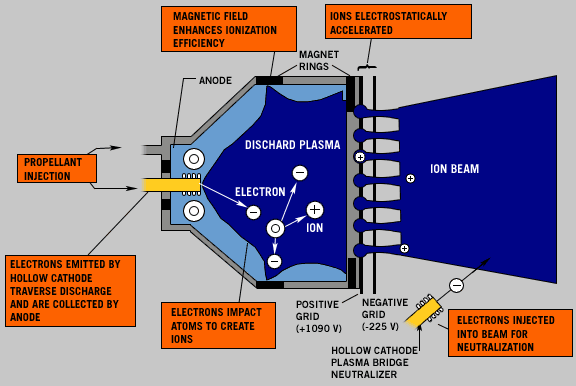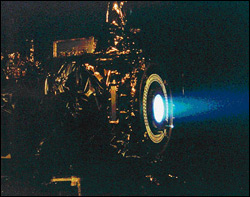NSTAR

NSTAR engine diagram.
NSTAR is an electron bombardment thruster – a type of ion propulsion system – developed by NASA and Hughes Research Laboratories (now part of Boeing). It was used to propel the Deep Space 1 probe. Although NSTAR works in the same way as its commercial counterpart, XIPS, which is used mainly for satellite station-keeping, NSTAR is larger and specifically designed for deep space missions that involve long periods of continuous thrusting and low levels of sunlight. The NSTAR system is also remotely programmable, which allowed NASA to adjust its thrust over the life of the DS1 mission.
 |
| DS1 firing its NSTAR ion propulsion system in a vacuum
chamber at the Jet Propulsion Laboratory prior to launch
|
NSTAR is an acronym of NASA SEP (Solar Electric Propulsion) Technology Application Readiness, a program started in November 1992 and run jointly by the Glenn Research Center and the Jet Propulsion Laboratory with the aim of validating low-power ion propulsion. The vehicle for this validation, Deep Space 1, carried about 81.5 kilograms of xenon propellant, sufficient for about 20 months of continuous thrusting and more than enough to propel the probe throughout its entire mission. The 30-centimeter NSTAR ion thruster on DS1 worked almost flawlessly and eventually changed the spacecraft's speed by about 4.2 kilometers per second (9,400 mph).
Technical details
The NSTAR engine, like XIPS and similar ion thrusters, is composed of several subsystems, including the discharge chamber, the discharge cathode assembly (DCA), the grids (also called the ion optics), and the neutralizer. Propellant is injected both through the DCA and through a ring of injectors. The DCA emits electrons that are accelerated by the electric field established between the positively biased discharge chamber walls and the negatively biased DCA. These electrons ionize the propellant by striking the gas atoms, knocking away one or more of the electrons orbiting an atom's nucleus. The "ring-cusp" magnetic field created by the magnets that surround the discharge chamber is used to improve the ionization efficiency of the engine by increasing the electron's residence time in the discharge chamber; that is, the longer an electron remains in the discharge chamber, the more opportunity it has to ionize propellant atoms.
The propellant used in NSTAR is a the chemically inert, colorless, gas xenon. This is the propellant of choice for most electrostatic engines because of its large mass and thus high thrust-to-current ratio and the relative ease by which it is ionized.
At the rear of the discharge chamber is the ion optics – a pair of molybdenum grids that are charged to high voltage. The upstream grid, called the screen grid, is maintained at DCA potential, which in the case of NSTAR is about 1,090 volts above spacecraft ground (reference) at full thruster power. The second grid, known as the acceleration grid, is biased some 225 volts below ground. The grids are each less than 1 mm thick and are placed about 0.7 millimeter apart from each other. Ions created in the discharge chamber enter the holes in the screen grid and are accelerated by the roughly 1,300-volt drop in potential established by the two grids. Ions emerge from the acceleration grid at speeds in excess of 142,000 kilometers per hour (88,000 mph). The electron-emitting neutralizer that is downstream of the acceleration grid keeps the spacecraft electrically neutral with respect to its environment by emitting one electron for every positively charged ion that leaves the thruster.
At full throttle, NSTAR consumes about 2,300 watts of electric power and puts out 90 millinewtons (0.02 lb) of thrust. This is comparable to the force exerted by a single sheet of paper or a paper clip resting on the palm of your hand. Typical chemical on-board propulsion systems, by contrast, produce far greater thrust (450 to 2250 newtons, or 100 to 500 pounds) but for far shorter times.
While the grid erosion from ion impingement is the leading cause of thruster mortality, an NSTAR ion thruster logged more than 22,000 hours (three years) of operation in a vacuum chamber without a hitch. Because ion thrusters accelerate ions separately from the electrons, these devices have a thrust density limitation (force per unit thruster exit area) that results from so-called space-charge effects. However, to achieve long life, the NSTAR ion thruster (like other ion thrusters) operates nowhere near the space-charge current limit.


